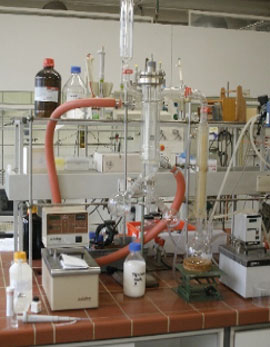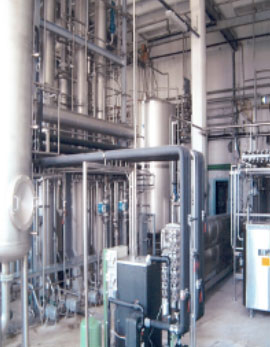Two-stage evaporators: Falling film evaporator and downstream thin film evaporator
Two-stage evaporator systems are typically realized in a first evaporator stage for the separation of larger solvent quantities in the falling film evaporator stage ideally suited for this purpose. A Thin Film Evaporator or Short Path Evaporator is then connected downstream for further concentration – usually to avoid significantly increased operating temperatures or for operation at significantly increased viscosities as a result of the pre-concentration. Often the second evaporator stage is to be run at lower operating pressures, e.g. to allow more gentle temperature conditions for high boilers. This corresponds to the option shown in the dashed diagram.
The feed or raw solution is fed into the first evaporator stage, the falling film evaporator EFF, and evenly distributed as a thin film over the circumference of the evaporator tubes by a special distribution system. The main part of solvent is to be evaporated in this stage and condensed either in condenser E12 or, at separate operating pressures, to the downstream evaporator in its own condenser E11 and discharged as distillate. The preconcentrate from the falling film evaporator flows into the second evaporator stage, usually a thin film evaporator. Here, the remaining components are separated from the concentrate by evaporation, then mostly for higher viscosities, higher solid contents or at lower operating pressures to avoid high process temperatures. The evaporated portion of E02 is condensed into E12 and continuously discharged as a distillate via pump P03. Similarly, the concentrate from the evaporator E02 is discharged by pump P02.
Vacuum pumps VP01 and VP11 are used to set the desired process conditions such as pressure and temperature, and thermostats (laboratory and pilot scale) are used for heating, evaporation and condensation. On a production scale, classic energy sources such as steam, thermal oil or cooling water, cooling brine and glycol are used. For processes with larger solvent quantities and low boiling temperature increases – which are typical for the falling film evaporator stage – energy recovery systems such as mechanical vapour recompression can be implemented, thus minimizing the need for the classical energy sources.
- Evaporators with low hold-up and corresponding short residence time with narrow residence time distribution and gentle operating conditions for
- Laboratory and pilot systems made of stainless steel with borosilicate glass 3.3 in standardized design, optional process-specific adaptations
- Production systems made of stainless steel in process- and customer-specific design
- Modular supplementary evaporator systems according to process requirements, e.g.
- Upstream and downstream evaporators, e.g. EFF-ETF system
- Flash-Box
- Process and customer-specific guidelines, e.g. ATEX, PED, FDA, GMP, ASME, UL standards
- Suitable for media with increased demands:
- Viscous and highly viscous media
- Heat-sensitive media
- Solids-containing media
- Higher-melting media
- Feasibility studies or existing expertise for typical applications
- Fatty acids and fatty acid derivatives
- By-products from the production of edible oil
- Special polymers or oligomers
- Pharmaceutical and cosmetic products
- Specialty chemicals
- Fragrances and flavourings
Labororatory / Pilot evaporator systems and preliminary tests

Besides the composition of distillate and/or residue or concentrate, product properties such as smell and colour are also relevant for many applications. Likewise, possible effects that may occur during evaporation, such as foaming or fouling on the heat transfer surface, must be taken into account. The latter cannot be determined or estimated theoretically, but require the possibility of a visual evaluation of the evaporation process. This can best be implemented in laboratory and pilot plants from COROSYS, which can be individually assembled according to a modular system.
Once the basic feasibility has been established, the process parameters for the design of a production plant shall be verified, i.e. heat transfer and maximum area-related evaporation rates or applicatory number of stages as well as the achievable yields and qualities shall be determined. For this purpose, COROSYS has a standardized series of pilot plants made of stainless steel (optionally also special materials) in various sizes and designs to choose from.
For new evaporation or distillation tasks, COROSYS offers in-house services ranging from literature research, thermodynamic simulations and laboratory tests to piloting of single systems or combinations of falling film (EFF), thin film (ETF) and short path evaporators (ESF), if necessary also in combination with rectification (ERF).
The main objectives and possibilities of preliminary studies/test distillations as well as laboratory and pilot plants are again briefly and clearly summarized in the following table:
| Pre-studies / Test distillations | Laboratory systems | Pilot systems | |
|---|---|---|---|
| Literature/Patent research, determination of substance data, themodynamic modelling of evaporation/rectification | Feasibility check | Detailed process data determination based on feasibility study and preselected evaporator system | |
| Stainless steel with borosilicate glass 3.3 | Stainless steel with borosilicate glass 3.3, optionally other materials | Stainless steel, optionally other materials | |
| Tests to determine feasibility / selectivity | Laboratory tests mostly with a pre-selected film evaporator system | Engineering of the production plant with dimensioning of apparatuses and media | |
| Comparison of the different film evaporator systems and subsequent pre-selection | Determination of the straightening process parameters and achievable yields and qualities | Detailed determination of process parameters and achievable yields and qualities | |
| Visual evaluation of system behaviour (colour, smell, foam, solids, deposits, …) | Consideration and visual evaluation of the system behaviour (colour, smell, foam, solids, …) | Consideration of the system behaviour (colour, smell, foam, solids, deposits, …) | |
| Coordination of the analytics | Sample quantities or very small production quantities | Larger sample quantities or small production quantities |
Standard systems and options for laboratory and pilot systems
In addition, there are numerous available options listed below. The options do not represent a complete characterization, but are intended to show the possibilities for the customer and to support the efficient development of a concept for feasibility, as far as the characterization is not done by the questionnaire for evaporation processes.
| Area | Option |
|---|---|
| Directives |
|
| Material |
|
| Feed |
|
| Evaporator |
|
| Vacuum system |
|
| Cold trap |
|
| Discharge of concentrate & distillate |
|
| Temperature control 1) |
|
| Other |
|
1) T = Thermostat S= Steam E=Electrical C= Cooling Media CW=Cooling Water
Production-scale evaporator systems
 Falling film evaporators can be very efficiently combined with thin film and short path evaporators on a production scale for many known applications and also for numerous new processes that have been dimensioned in advance through studies and tests. The production plants are preferably designed as package units. This reduces the planning effort on the one hand and, in particular, the installation and commissioning time at the customer’s site on the other.
Falling film evaporators can be very efficiently combined with thin film and short path evaporators on a production scale for many known applications and also for numerous new processes that have been dimensioned in advance through studies and tests. The production plants are preferably designed as package units. This reduces the planning effort on the one hand and, in particular, the installation and commissioning time at the customer’s site on the other.
The two-stage evaporator systems on a production scale are individually dimensioned for customer processes. The typical and most common evaporator sizes range from 2.5 m² to over 100 m² for the falling film evaporator stage and less than 1.5 m² for the thin film or short path evaporator stage. For larger plants it is attempted to integrate a heat recovery system suitable for the respective process in the falling film evaporator stage, for example by preheating the feed stream with hot product streams or by mechanical vapour recompression.
In some cases, specific cyclical cleaning processes are also required, which we would be pleased to develop together with you.
The construction of the production systems is performed in compliance with the required directives such as DGRL 2014/68 EU or ASME, ATEX 2014/34 EU, UL standards, GMP guidelines, TA-Luft and the machinery directive 2006/42/EG.
Operation is typically carried out at temperatures up to 250 °C in the vaporiser and working pressures up to 1 mbar absolute at the column head. This includes laboratory and pilot scale operation.


